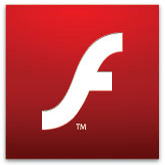 Remember last year how Apple snubbed Adobe, not allowing Flash on iDevices? Apple proclaimed Flash was a closed platform (the irony), it was inefficient, bulky, insecure, etc. as reasons for not allowing it on Apple’s mobile devices. At the time many shrugged it off as Apple being Apple, especially since Flash was on its way to other mobile devices namely Android. As it turns out, Apple was semi-right. Flash has been mostly a failure on Android and BlackBerry OS. It works on some devices but doesn’t work on many others without crashing; even flagship devices that promise to launch with Flash – such as Motorola Xoom and BlackBerry Playbook – have been unable to successfully port Flash. Now Adobe has thrown in the towel; they have officially announced they will no longer develop Flash for mobile devices after Flash Player 11.1, only providing security updates for existing solutions:
Remember last year how Apple snubbed Adobe, not allowing Flash on iDevices? Apple proclaimed Flash was a closed platform (the irony), it was inefficient, bulky, insecure, etc. as reasons for not allowing it on Apple’s mobile devices. At the time many shrugged it off as Apple being Apple, especially since Flash was on its way to other mobile devices namely Android. As it turns out, Apple was semi-right. Flash has been mostly a failure on Android and BlackBerry OS. It works on some devices but doesn’t work on many others without crashing; even flagship devices that promise to launch with Flash – such as Motorola Xoom and BlackBerry Playbook – have been unable to successfully port Flash. Now Adobe has thrown in the towel; they have officially announced they will no longer develop Flash for mobile devices after Flash Player 11.1, only providing security updates for existing solutions:
Our future work with Flash on mobile devices will be focused on enabling Flash developers to package native apps with Adobe AIR for all the major app stores. We will no longer continue to develop Flash Player in the browser to work with new mobile device configurations (chipset, browser, OS version, etc.) following the upcoming release of Flash Player 11.1 for Android and BlackBerry PlayBook. We will of course continue to provide critical bug fixes and security updates for existing device configurations. We will also allow our source code licensees to continue working on and release their own implementations.
Adobe will, of course, continue to develop Flash for traditional computers; and they will refocus their efforts on HTML5:
These changes will allow us to increase investment in HTML5 and innovate with Flash where it can have most impact for the industry, including advanced gaming and premium video. Flash Player 11 for PC browsers just introduced dozens of new features, including hardware accelerated 3D graphics for console-quality gaming and premium HD video with content protection. Flash developers can take advantage of these features, and all that our Flash tooling has to offer, to reach more than a billion PCs through their browsers and to package native apps with AIR that run on hundreds of millions of mobile devices through all the popular app stores, including the iTunes App Store, Android Market, Amazon Appstore for Android and BlackBerry App World.
We are already working on Flash Player 12 and a new round of exciting features which we expect to again advance what is possible for delivering high definition entertainment experiences. We will continue to leverage our experience with Flash to accelerate our work with the W3C and WebKit to bring similar capabilities to HTML5 as quickly as possible, just as we have done with CSS Shaders. And, we will design new features in Flash for a smooth transition to HTML5 as the standards evolve so developers can confidently invest knowing their skills will continue to be leveraged.
In an era that has seen the the end of many eras, this is one of the more significant ones. Sure this change is only for mobile devices but it doesn’t take a genius to see how this may affect Flash’s stranglehold on PCs.
Apple wins. This time. Again.
[via Adobe]

 Email article
Email article



